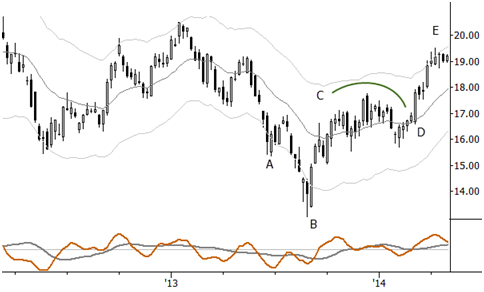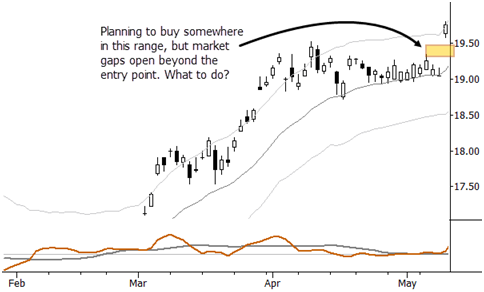[dc]T[/dc]oday I want to take a look at the recent move in India’s stock market. I will discuss how we traded it (and signaled the move far in advance) in the research I write for Waverly Advisors, but, even more importantly, there are lessons for trade management and pattern recognition that are a valuable addition to the trader’s toolkit.
First, 2014 has been a frustrating year for many traders. Intraday, there has been plenty of action in stocks and futures, but traders looking for even moderately-sized moves over a few days in stocks, commodities, and currencies have had a rough time. Yes, there has been money to be made, but this has been an environment that punishes any mistakes. Most “swing traders” (quotes because I think that term usually a misnomer) survive through periods like this by chipping away: small gains and small losses, and hopefully the gains net out to a little bit more than the losses. When the edge is this small, you can’t afford to be sloppy: hold one trade too long, miss a trade, ignore a stop, and you can find yourself netting a significant loss for a period that should be breakeven at worst. Every trading methodology (except some HFTs) has losing periods. Plan for them and don’t be surprised when they come.
It’s also worth mentioning that your job as a trader is to find the best opportunities, put on the appropriate position, and then manage the risk. Keep in mind that, when you review trades after the fact, some will look very bad when they were, in fact, excellent opportunities at the time. Too many developing traders attach too much significance to specific trade reviews, and focus on the wrong aspects, but that’s a topic for another day. No matter how subpar you think the environment is, your job is to put on the trades as they come along. Otherwise, you miss risking the one or two trades that would take you to a net profit. In 2014, we’ve only had a handful of clean moves: the recent rally in India was one of them.

The chart above is a weekly chart of EPI, an earnings-weighted ETF for the Indian stock market. (I do not advocate doing analysis on exchange traded products (yes, even avoid GLD!), but we executed the trade in EPI, so I will use it for consistency, rather than the cash index I use for analysis.) A chart, of course, is a past record of prices, but such a statement belies their usefulness. If we understand the message of the chart correctly, we can understand the current balance of buying and selling pressure in the market, can avoid those places where the market is in relative equilibrium, and can find trading edges. To my thinking, there is little value in historical chart analysis, except for learning to read charts. All the action is at that “hard right edge”, and all useful chart analysis must answer two questions: 1) is there an edge in this market? (The answer is usually no.) 2) What is that edge and how can we trade it?
Understanding the history of the market, where it has been, can give us a better understanding of where the market is now. Consider the important technical features from the last year or so of EPI’s trading activity. A) A clean bear flag followed by a sharp selloff that results in another bearish setup at B). This setup fails, leaving a long lower shadow, and then a sharp reversal from the lows. At this point, if you’re a bear, it makes sense to at least move to cash. Don’t short after a reversal like this. C) marks a broad area that can charitably be described as “technical garbage”: this is a market is relative equilibrium (stays around the moving average), but new life comes into the market at D) with a sharp upthrust. After a short consolidation, another thrust to E) sets up another long trade following a consolidation at the right edge of the chart.
Now, that may not appear to be an in depth analysis. From a technical perspective, what’s missing? No discussion of trendlines, wave counts, retracement ratios, cycles, tests of moving averages, candlestick patterns, volume, divergence, or even chart patterns beyond the very rudimentary sharp thrusts and consolidations. Why? Well, first of all, a lot of that other “stuff” fails the tests for statistical significance, meaning that, over a large sample size, it appears to be as good as flipping a coin. However, the real reason is you don’t need it. With very simple, almost minimalistic tools, you can derive a significant and consistent trading edge. Focus attention on what works.

Now look at the daily chart, above. We had been planning to buy an upside breakout, and knew that there would be significant slippage in this ETF because the actual trading happens outside of US market hours. (That can be a significant factor in many ETFs, ADRs, and currency futures.) In this case, the market gapped up far above our entry point. Ask yourself, what would you do? Do you A) skip the trade as the risk is now higher, B) wait for a pullback, C) do something like buy a little now and hope to buy the rest on a pullback, or D) do something else? Whatever you do, you need to be consistent. That means you have a plan, have thought the plan out in advance, and trade the plan, not your emotional reaction at the time. I’ll revisit this trade in a blog post later this week and we will discuss the tradeoffs and how to manage risk in a situation like this.
Pingback: Wednesday links: taking enough risk | Abnormal Returns